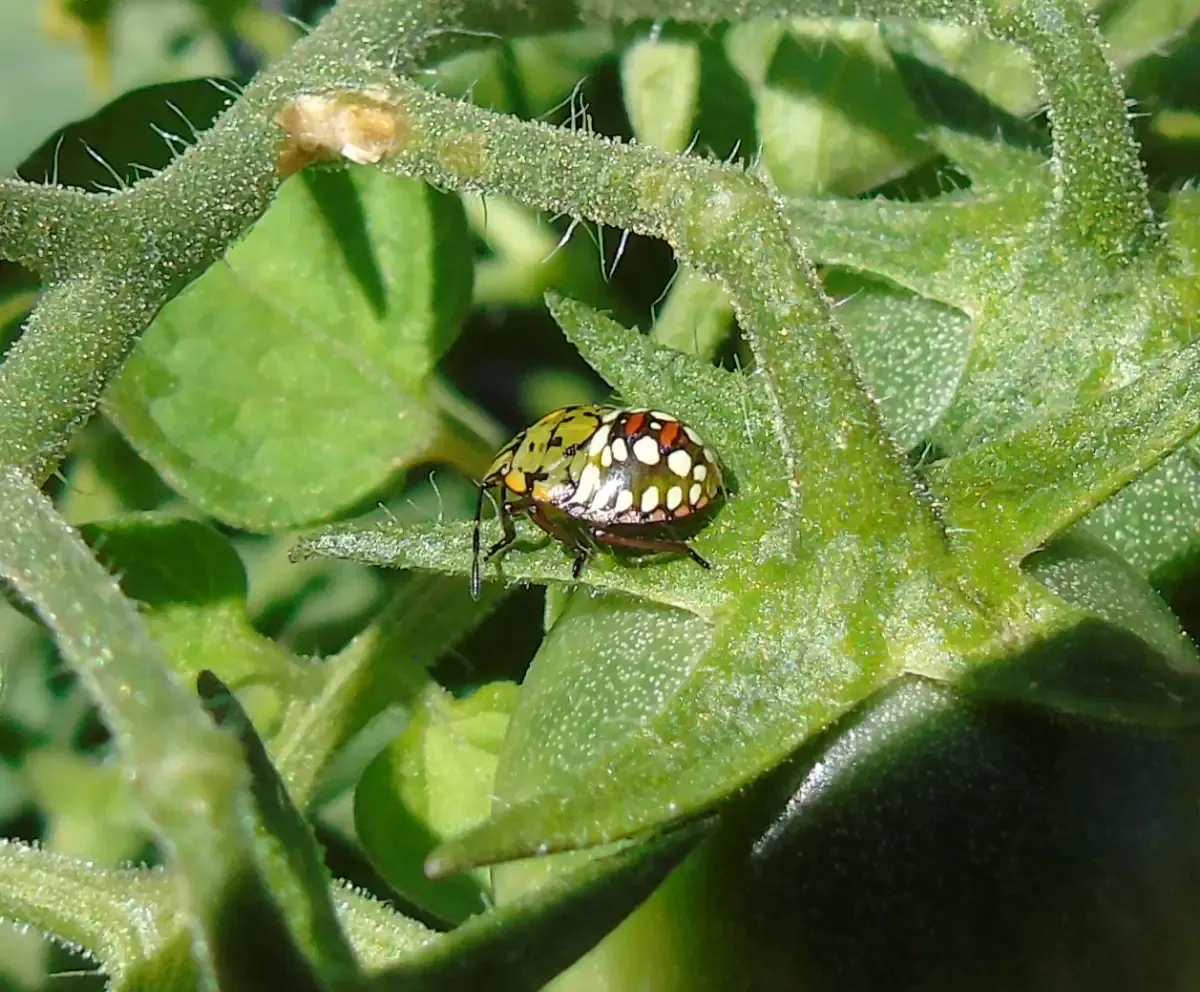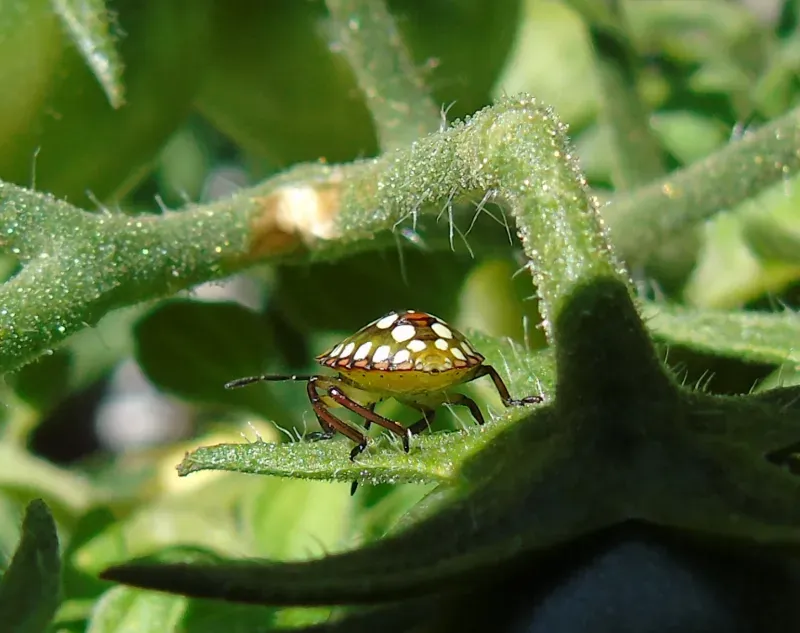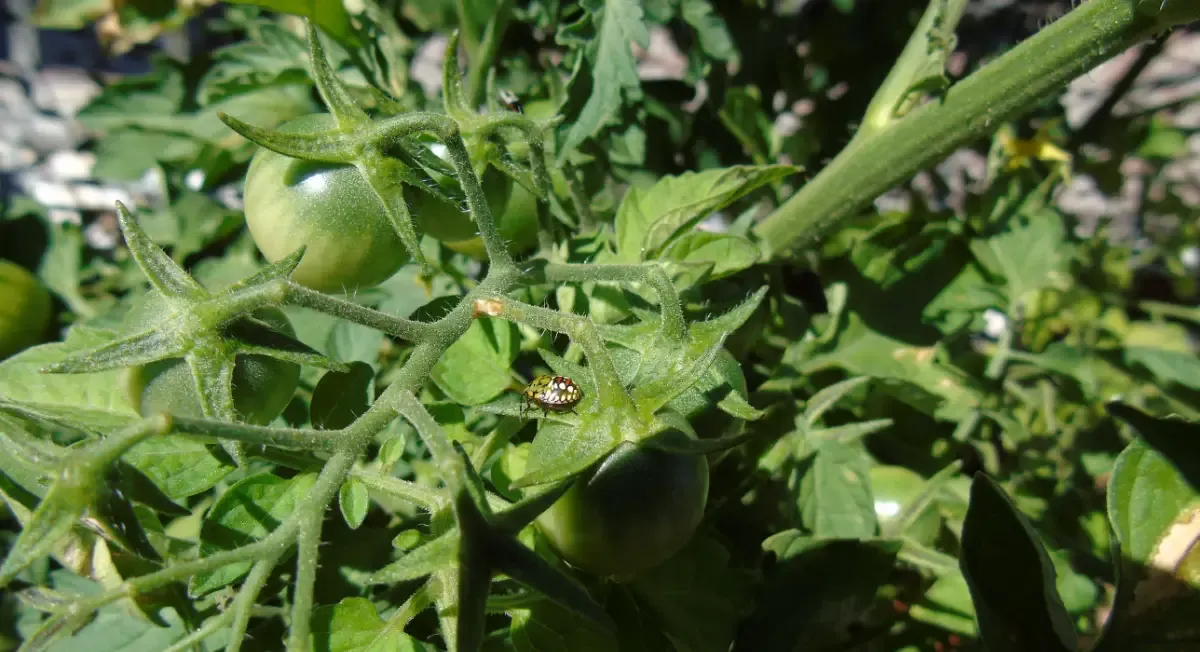How I Became a Garden Vigilante: My War Against the Tiny Green Mafia

When invasive stink bugs turn your peaceful tomato sanctuary into a crime scene, sometimes you have to take matters into your own hands (literally).
Meet Nezara viridula
Also known as: The Southern Green Stink Bug
Also known as: The Tomato-Terrorising Tiny Green Menace
Also known as: The Reason I Now Have Trust Issues in My Terrace Garden
So there I was, peacefully tending to my three tomato plants (grown lovingly from seed, no less — we're talking proper horticultural parenting here), when I noticed them.
Tiny. Brightly coloured. Shiny. Smug.
Nezara viridula had arrived.
The Teenage Delinquent Phase
Here's where it gets interesting (and slightly embarrassing for my insect identification skills): these little menaces weren't actually green. Despite being called the "Southern Green Stink Bug," they only turn green when they reach full adulthood. The colourful criminals I discovered were in their third instar — basically teenage bugs going through their rebellious phase.

Caught red-handed: A third instar Nezara viridula in full "I'm-not-supposed-to-be-here" mode, casually treating my homegrown tomato like an all-you-can-eat buffet. Note the bright colouration: these teenage delinquents won't turn green until they reach full adulthood.
An instar, for those who didn't major in "Things That Eat My Vegetables," is like a growth stage for insects. Think of it as bug puberty, but with more moulting and less attitude (though arguably just as destructive). These particular teenagers were sporting bright colours like tiny warning signs that screamed "We're here to ruin your day!" According to iNaturalist, my little assassins were right in that sweet spot of being old enough to cause maximum damage but young enough to still be showing off with flashy colours.
So technically, I committed infanticide against a bunch of flamboyant bug teenagers. Zero regrets.
The Invasion Begins
This isn't just some cute little bug passing through on holiday. This is an invasive stink bug, hailing originally from Ethiopia but now gallivanting across the globe like it owns the place. And in this case, it had decided to colonise my tomatoes. MY tomatoes. The jewels of my balcony garden.
Let me set the scene:
You grow your own food. You water it. You whisper sweet nothings to it during your morning coffee. You name your cucumbers. You consider singing lullabies to your bell peppers.
And then... THEM.
Suddenly your tomatoes are looking a bit... chewed. You lean in closer. BAM — a stink bug is casually piercing your beloved tomato with its little beaky face-straw like it's sipping an overpriced smoothie at a trendy café.
Well, dear readers, I did what any rational, plant-loving, tomato-defending human would do.
I squashed them. With my fingers. No regrets. I didn't even flinch. Invasive pest in Italy + eating my tomatoes = capital crime in my garden jurisdiction.
Of course, squashing them released their signature "eau de despair" (stink bug juice smells like bad decisions and leaf rot), but justice was served.

The perpetrator at work: This colourful little criminal is using its needle-like proboscis to pierce my tomato's skin, creating the perfect entry point for rot and general garden heartbreak. Notice how utterly unbothered it looks.
The Stink Bug Buffet: What's on Their Menu
Here's the thing about Nezara viridula: they're not picky eaters. They're basically the omnivorous toddlers of the insect world, except instead of refusing vegetables, they devour ALL vegetables.
Their favourite targets read like a grocery list of everything you actually want to grow:
Legumes (because apparently they hate your protein dreams): beans, peas, lentils, chickpeas. They pierce the pods and suck out the developing seeds like they're slurping bubble tea. Your dreams of homegrown hummus? Crushed.
Solanaceous crops (the tomato family tree of despair): tomatoes, peppers, aubergines, potatoes. They love these so much they'll basically set up camp and start charging rent. They pierce the fruits and leave behind dimpled, discoloured patches that look like tiny crime scenes.
Brassicas (your cruciferous vegetables are not safe): cabbage, broccoli, cauliflower, Brussels sprouts. They attack the developing heads and leaves, turning your winter vegetable plans into Swiss cheese.
Cucurbits (because summer squash dreams must die): cucumbers, courgettes, melons, squash. They target both the fruits and the stems, creating weak points that invite other diseases to the party.
Sweetcorn (because even your grain dreams aren't sacred): they love to pierce developing kernels, creating entry points for mould and rot.
Official Sanction for Garden Vigilantism
Our local Agricultural Institute, L'Istituto Agrario di San Michele all'Adige, has basically issued a botanical fatwa against these green menaces. They've literally begged gardeners to kill stink bugs on sight — whatever type, no questions asked. When agricultural scientists are essentially saying "shoot first, ask questions later," you know the situation is serious.
It's like having official permission to be a garden assassin. The Institute didn't just suggest control methods — they practically handed us tiny wanted posters and said "make it happen."
So when I squashed those bugs with my bare hands, I wasn't just protecting my tomatoes. I was performing my civic duty as a responsible gardener. Badge of honour, really.
The Civilised Gardener's Arsenal: Organic Pest Control That Actually Works
Now, before you all think I'm some sort of garden vigilante who goes around thumb-wrestling insects to death, let me share some slightly more sophisticated approaches I've learnt (the hard way) for dealing with these green invaders.
The Soapy Water Assassin
Mix a few drops of washing-up liquid with water in a spray bottle. It's like giving the bugs a bubble bath they'll never recover from. The soap breaks down their waxy coating, and they basically slide off your plants like they're on a water slide to nowhere. Effective, eco-friendly, and you get to feel like a mad scientist.
The Neem Oil Negotiator
Neem oil is the diplomat of the pest control world. It doesn't kill bugs outright — it just makes them really uncomfortable and convinces them to relocate. Think of it as the equivalent of playing death metal at full volume until your annoying neighbours move out.
The Companion Plant Bodyguards
Plant marigolds, basil, or nasturtiums around your tomatoes. These plants are basically the bouncers of the garden world: they smell weird to bugs and create a "nope, not today" barrier. Plus, you get herbs for cooking. Win-win.
The Dawn Patrol Method
Go out early in the morning when the bugs are slow and drowsy (like me before coffee). Hand-pick them into a jar of soapy water. It's meditative, in a slightly murderous way. Think of it as pest control yoga.
The Diatomaceous Earth Fortress
Sprinkle food-grade diatomaceous earth around your plants. It's like creating a microscopic glass battlefield that bugs don't want to cross. Safe for humans and pets, but feels like walking on broken glass if you're a soft-bodied insect.
The Emotional Aftermath
They say "every life has value" and that's beautiful. But they weren't looking at my tomato plants while a bug was turning them into mushy crime scenes.
To be clear, my modest garden — three tomato plants, three cucumbers, six bell peppers — won't save us in a zombie apocalypse. But these plants are sentimental warriors. They are the legacy of springtime dreams, born of seed trays and stubborn hope. And I'll be buggered if I let Nezara viridula ruin that.
The truth is, gardening teaches you that sometimes you have to make hard choices. Sometimes you have to be the villain in someone else's story (even if that someone is a stink bug). And sometimes, despite your best organic intentions, you just grab the nearest garden glove and do what needs to be done.
R.I.P. stink bugs. May your next life involve a strong aversion to solanaceous crops.
Have you encountered these green menaces in your garden?
What's your go-to organic pest control method?
Share your war stories in the comments. I need to know I'm not the only one with tomato-related trust issues.